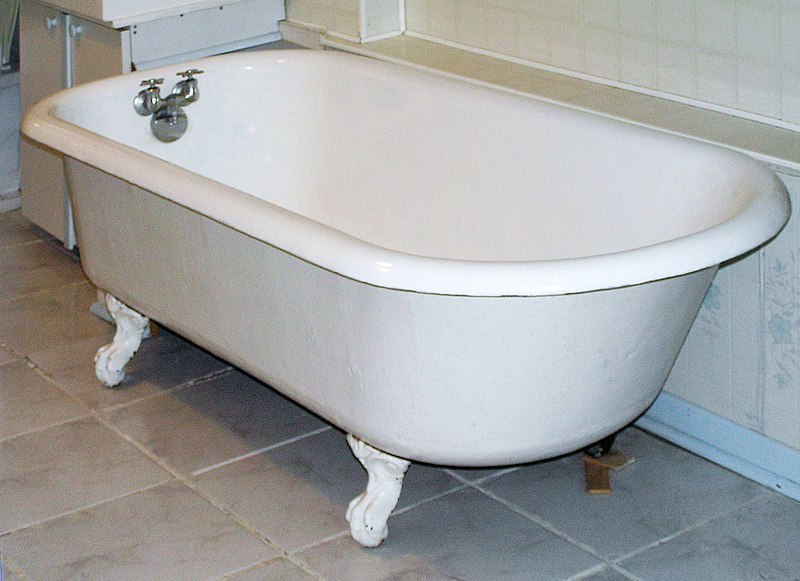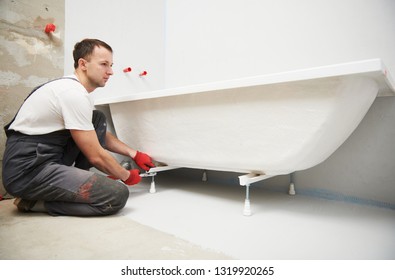Just How to Remove and Change a Tub
Just How to Remove and Change a Tub
Blog Article
This great article which follows pertaining to A Step-by-Step Guide to Installing a Bathtub is quite captivating. Try it and make your own personal conclusions.

Installing a tub isn't specifically brain surgery, but it does need solid plumbing, carpentry, and also sometimes, tiling skills. Replacing an old bath tub with a brand-new one is also a moderately tough task. If the old bathtub is readily accessible, the task can move rapidly; if you need to open up a wall to eliminate the old bathtub and also place the brand-new bathtub, the task is a lot harder. In either situation, the job is within a house handyman's abilities, although you will certainly need a helper to leave the old bathtub and also embeded in the brand-new one. Make sure you have actually qualified yourself for the task and also are comfortable attempting it. Instead of employing a service provider to take control of a halfway-completed task, it is far better to take into consideration using one prior to you start. Possibilities are you may require a specialist plumber to make tube links.
This short article will assist you install a new bath tub in your washroom if you have actually currently gotten a new tub as well as do not require to transform the setup of your previous water pipelines.
Your devices and also product list must make up the following:
Removing Old Taps
If you need to change old faucets with brand-new ones as a part of your setup, after that the first thing you should do is separate the water. After doing so, activate the faucets to drain pipes any type of water staying in the system. The process of getting rid of the existing faucets can be rather troublesome due to the restricted access that is often the case.
Make use of a container wrench (crowsfoot spanner) or a faucet device to undo the nut that links the supply pipelines to the faucets. Have a fabric ready for the continuing to be water that will certainly originate from the pipes. Once the supply pipelines have actually been eliminated, use the same device to loosen the nut that holds the taps onto the bath/basin. You will certainly require to stop the solitary taps from turning throughout this procedure. Once the faucets have actually been eliminated, the holes in the bath/basin will need to be cleaned up of any old securing compound.
Prior to carrying on to fit the new faucets, compare the pipeline connections on the old taps to the new taps. If the old faucets are longer than the new taps, after that a shank adapter is required for the brand-new taps to fit.
Suitable New Taps
If the tails of the new faucets are plastic, then you will certainly require a plastic connector to stop damage to the string. One end of the port fits on the plastic tail of the tap and also the other end gives a connection to the current supply pipes.
If you require to fit a monobloc, then you will certainly require lowering couplers, which links the 10mm pipeline of the monobloc to the common 15mm supply pipe.
Next off, place the tap in the placing hole in the bath/basin making certain that the washers remain in location in between the tap and also the sink. Secure the faucet in place with the maker provided backnut. As soon as the tap is firmly in place, the supply pipelines can be connected to the tails of the taps. The faucets can either be connected by utilizing corrugated copper piping or with normal tap adapters. The former kind should be linked to the tap finishes first, tightening up only by hand. The supply pipes can later on be connected to the various other end. Tighten up both ends with a spanner after both ends have been linked.
Mounting the Bathtub
Utilizing both wood boards under its feet, place the tub in the called for placement. The wooden boards are useful in equally spreading out the weight of the bathtub over the location of the boards as opposed to concentrating all the weight onto four little factors.
The next objective is to make certain that the bath tub is leveled all round. This can be achieved by inspecting the spirit level as well as adjusting the feet on the bathtub up until the level checks out level.
To set up faucets, fit all-time low of the outermost adaptable faucet adapter to the ideal supply pipeline by making a compression join; after that do the very same for the various other faucet.
Activate the water supply and check all joints and also brand-new pipework for leakages and also tighten them if essential. Fill the bath tub as well as additionally inspect the overflow electrical outlet as well as the typical electrical outlet for leakages.
Lastly, take care of the bathroom paneling as explained in the maker's user's manual. Tiling and securing around the bath tub needs to wait up until the bathtub has been used at least when as this will certainly resolve it into its final placement.
Planning for the Installment
To start with, the sustaining framework supplied with the bathroom ought to be fitted (if required) according to the manufacturer's instructions. Next, fit the faucets or mixer to the bath tub. When fitting the tap block, it is important to see to it that if the faucet includes a plastic washer, it is fitted between the bath and the taps. On a plastic bathroom, it is additionally practical to fit a supporting plate under the taps system to stop pressure on the tub.
Fit the versatile tap connectors to the bottom of the two faucets making use of 2 nuts and also olives (often supplied with the tub). Fit the plug-hole outlet by smearing mastic filler round the sink outlet opening, and after that pass the outlet via the hole in the bathroom. Utilize the nut supplied by the manufacturer to fit the plug-hole. Examine the plug-hole outlet for an inlet on the side for the overflow pipe.
Next off, fit completion of the adaptable overflow pipeline to the overflow outlet. After that, screw the pipeline to the overflow face which ought to be fitted inside the bathroom. Make certain you utilize every one of the provided washers.
Attach the trap to the bottom of the waste outlet on the tub by winding the thread of the waste electrical outlet with silicone mastic or PTFE tape, and screw on the catch to the electrical outlet. Link all-time low of the overflow tube in a comparable manner.The bathroom must now be ready to be suited its last setting.
Tiling Around the Tub
In the area where the bath fulfills the ceramic tile, it is required to seal the accompanies a silicone rubber caulking. This is very important as the fitting can relocate enough to fracture a stiff seal, creating the water to penetrate the wall surface in between the bath and also the tiling, resulting in difficulties with dampness and also possible leakages to the ceiling below.
You can select from a selection of coloured sealants to assimilate your fixtures as well as fittings. They are offered in tubes and also cartridges, as well as are capable of sealing gaps as much as a width of 3mm (1/8 inch). If you have a bigger gap to fill up, you can load it with spins of drenched newspaper or soft rope. Keep in mind to constantly fill up the tub with water prior to sealing, to allow for the motion experienced when the tub remains in use. The sealer can fracture relatively very early if you do not take into consideration this activity before securing.
Alternatively, ceramic coving or quadrant ceramic tiles can be made use of to edge the bath or shower tray. Plastic strips of coving, which are easy to use and also cut to dimension, are also conveniently available on the marketplace. It is advisable to fit the ceramic tiles utilizing waterproof or waterproof glue and also grout.
Bathtub Installation
How Important Is A Bathtub To Your Home?
High-quality baths, showers, and other bathroom updates are necessary when considering a smart investment in your home. It’s a room that you go to every day and one that is constantly being used by guests.The bathroom is one of the top trafficked rooms in a home and also one of the most valuable in terms of home resale.
Install Piping Before Tub
You will be using your existing drain and waste vent system, but pipes required include the hot and cold water supply lines and a pipe leading to a shower head. A mixing valve and shower head are also needed. Air chambers may be required.
Position the Tub
Lower the tub into place so that the continuous flange fits against the wall studs and rests on 1’x4' or 2’x4' supports. Anchor the tub to the enclosure with nails or screws inserted through the flanges into the studs.
NOTE: Remember, bathtubs and shower stalls may require support framing. A bathtub filled with water is extremely heavy, so check building codes and framing support before installing the tub.
Assemble Drain Connections
Assemble the bathtub drain connections by connecting the tub overflow with the tub drain above the trap, not beyond it. The trap will have a compression fitting that screws over the arm of the overflow assembly.
Place a Pipe For the Shower Head
First, locate a brass female threaded winged fitting and attach it to a framing support via a screw or a nail. Then run a pipe up the wall for the shower head. Sweat or solder the other side of the brass fitting to the top of the pipe.
Attaching Hot and Cold Water Lines
Attach your water lines for both hot and cold by sweating these directly into the hot and cold ports of the mixing valve. The mixing valve will be how water enters the tub’s system, not by the pipes themselves.
Install the Spout
Extend a piece of 1/2 inch pipe, or whichever length is specified in the manufacturer’s instructions, for the tub spout. Sweat on a male threaded fitting at the end of the pipe or use a brass nipple of the proper length and a 1/2 inch cap.
NOTE: At this point you should have your rough-in plumbing work inspected before proceeding further.
Check For Leaks
Restore the water pressure and check the drain connection and the supply pipes for any sign of leaking.
estore the Bathroom Wall
Replace the wall with moisture-resistant drywall as a base for your wall covering. Seal the joints between the wall and your new tub with silicone caulk as protection against water seepage.
https://www.berkeys.com/2016/12/02/bathtub-installation-dallas/

Do you appreciate reading about A Step-by-Step Guide to Installing a Bathtub? Make a remark down the page. We will be glad to listen to your thoughts about this write up. Hoping to see you back again in the near future. Do you know another person who is interested by the subject? Why not promote it. I recognize the value of reading our article about How to Install a Bathtub Yourself.
Visit Website
Report this page